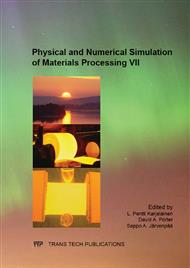p.584
p.590
p.596
p.602
p.607
p.612
p.621
p.627
p.633
Characterizing the Decomposition of Ti2AlC during its Brazing with Cu by Using Ag-Cu Filler Alloy
Abstract:
The reaction process between Ti2AlC and Ag-Cu filler alloy was mentioned in our previous study. However, the reaction mechanism between Ti2AlC and filler alloy remained uncertain due to the existence of TiAl2, which was widely distributed in the dual-phase Ti2AlC substrate and exhibited intense reaction with Cu. In current research, pure-phase Ti2AlC was brazed to Cu using Ag-Cu filler alloy respectively at 850°C and 900°C for 10 min. First of all, to investigate the influence of TiAl2 on clarifying the reaction mechanism, Ti2AlC substrates with different component (single phase and dual phase) were joined to Cu at 850°C for comparison. However, in these joints, it was difficult to find any other reactant except for AlCu2Ti. Thus, the pure-phase Ti2AlC was brazed to Cu at 900°C, aiming to intensify the interaction between substrates and filler alloy. For characterizing the microstructure evolution in the joint, the typical region of the joint that contained all the reactants was selected and sliced by focused ion beam technology. Combining with transmission electron microscopy, all the decomposition products (e.g. Ti3AlC2 and TiC) in the joint were identified. Then the decomposition mechanism of Ti2AlC was clearly disclosed.
Info:
Periodical:
Pages:
607-611
Citation:
Online since:
July 2013
Authors:
Keywords:
Price:
Сopyright:
© 2013 Trans Tech Publications Ltd. All Rights Reserved
Share:
Citation:


